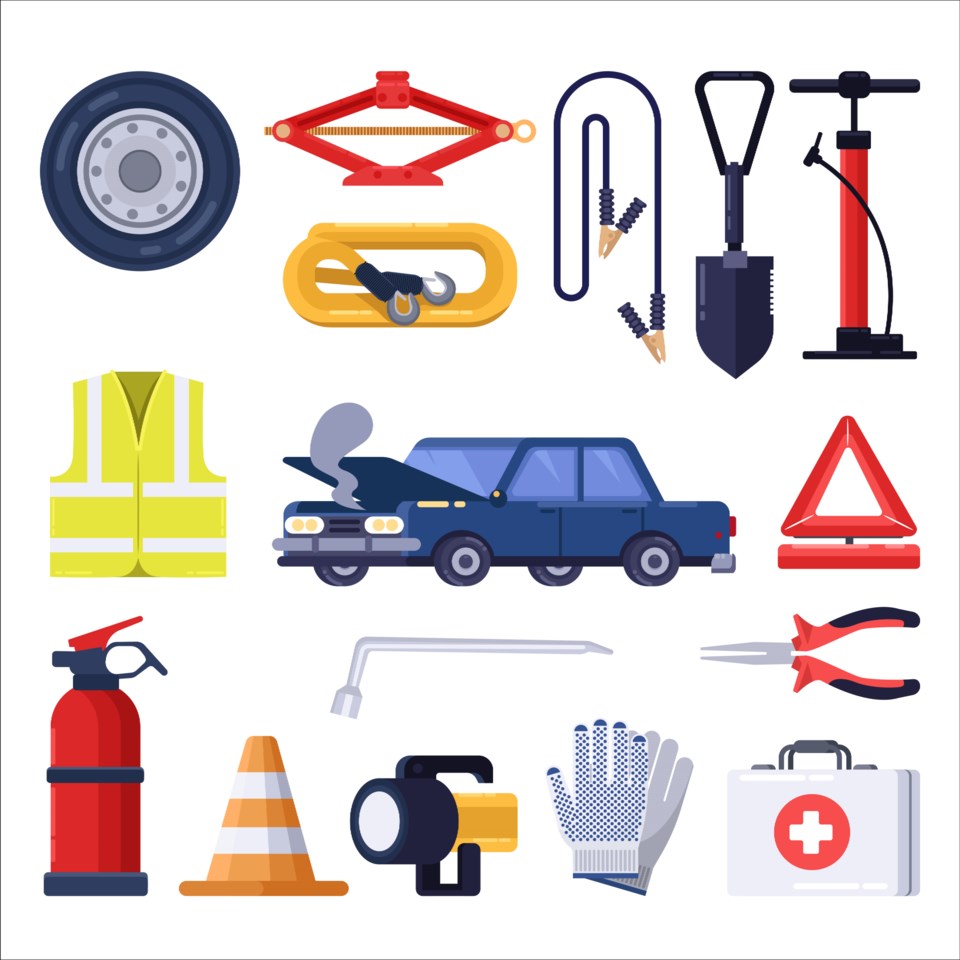There's panic buying, and then there's planning. Putting together an emergency car kit falls in the latter category.
The following chosen items are based on federal government guidelines and some advice from people who have been on the front lines of floods, wildfires and the heat dome.
COMPLETE EMERGENCY CAR KIT OPTIONS
Need a one-and-done option?
When picking a pre-assembled emergency car kit, be sure to choose something that suits your needs while checking off all the basics. That includes a first aid kit, seatbelt cutter, small shovel, candles and matches, flashlight, whistle, jumper cables, tow rope, warning lights, or road flares.
If you're a commuter or not travelling too far outside of urban areas, consider an emergency kit that checks all those basic boxes, such as the Premium Auto Safety Kit from Canadian Tire or a 62-piece emergency kit from Rona.
Similarly, there are emergency car kits geared toward people taking road trips, driving a road less travelled that could potentially see them in a tough spot should an accident occur, and driving in inclement weather. In that case, look for a more comprehensive kit that accounts for just how long you may need it and repairs you may need to make to get back on the road.
Finally, your vehicle may call for a different kind of emergency kit, too. Pre-assembled electric vehicle emergency kits are a bit more challenging to find in Canada. Still, if you're willing to arrange the shipping and duties, this one is available from a U.S. retailer.
DIY EMERGENCY CAR KIT COMPONENTS
For those who prefer to pack their kit for their specific circumstances—including your average number of people and pets who may be with you—you'll want to have the following core items in your go-to emergency pack.
DUFFEL BAGS
A sturdy nylon duffel bag with lots of space and compartments works well if you need to abandon your vehicle and go on foot. There are basic duffel bags available online, which will do the trick, but for a few dollars more, you can get a more rugged duffel bag designed for outdoor life to keep your items dry.
GLASS BREAKERS/SEAT BELT CUTTERS
It sounds like an action movie, but a tool that can break glass and cut through a seat belt is a standard in most emergency kits. Amazon has a set of two, and Canadian Tire has a 5-in-1 torchlight and multifunctional tool.
WARMING BLANKETS
If you're stuck overnight, you're going to need to make sure you're warm and dry. There are plenty of options, from heat-retaining space blankets (the same kind used by search-and-rescue teams) to emergency sheets to emergency sleeping bags that come complete with a whistle, carabiner and a cord that doubles as emergency tinder to start a fire.
Similarly, you can also add a basic two-person emergency tent to your kit.
EMERGENCY SUPPLIES
A pre-stocked first aid kit built for travel has the benefit of convenience. Opt for one that is both waterproof and smaller so that it can be tucked inside a more oversized bag.
In addition to a first-aid kit, you'll also want to add the other items from the Canadian government's emergency kit checklist, including a small fire extinguisher, flares, candles and waterproof matches, tow rope, sand (or salt), antifreeze, a whistle, a wind-up flashlight or lantern, and a small shovel.
Gloves are included in most emergency kits for a reason: they are a must for protection and safety. Mark's has a selection under work gloves, as does Canadian Tire and Rona.
For the emergency-within-an-emergency, these bathroom funnels could come in handy if there's an urgent need to "go," but it's not safe to get out of the car.
FOOD AND WATER
Do you keep water and snacks on hand?
Search-and-rescue crews recommend having at least two litres of water per person for three days available.
Those bottles will need to be replaced by the expiry date—typically 12-24 months. You could also opt for emergency water pouches, which are suitable for up to five years and take up less room in your vehicle's trunk or vehicle's emergency kit. It also doesn't hurt to keep water purification tablets on hand as they take up very little space in a bag but could be a literal lifesaver.
Non-perishables are needed, but canned food doesn't make much sense in a car unless you're also packing a can opener. Instead, opt to keep energy bars, low-sodium crackers, dried fruit, nuts, jerky and even protein-heavy chocolate peanut butter cups on hand—mind the expiry dates.



